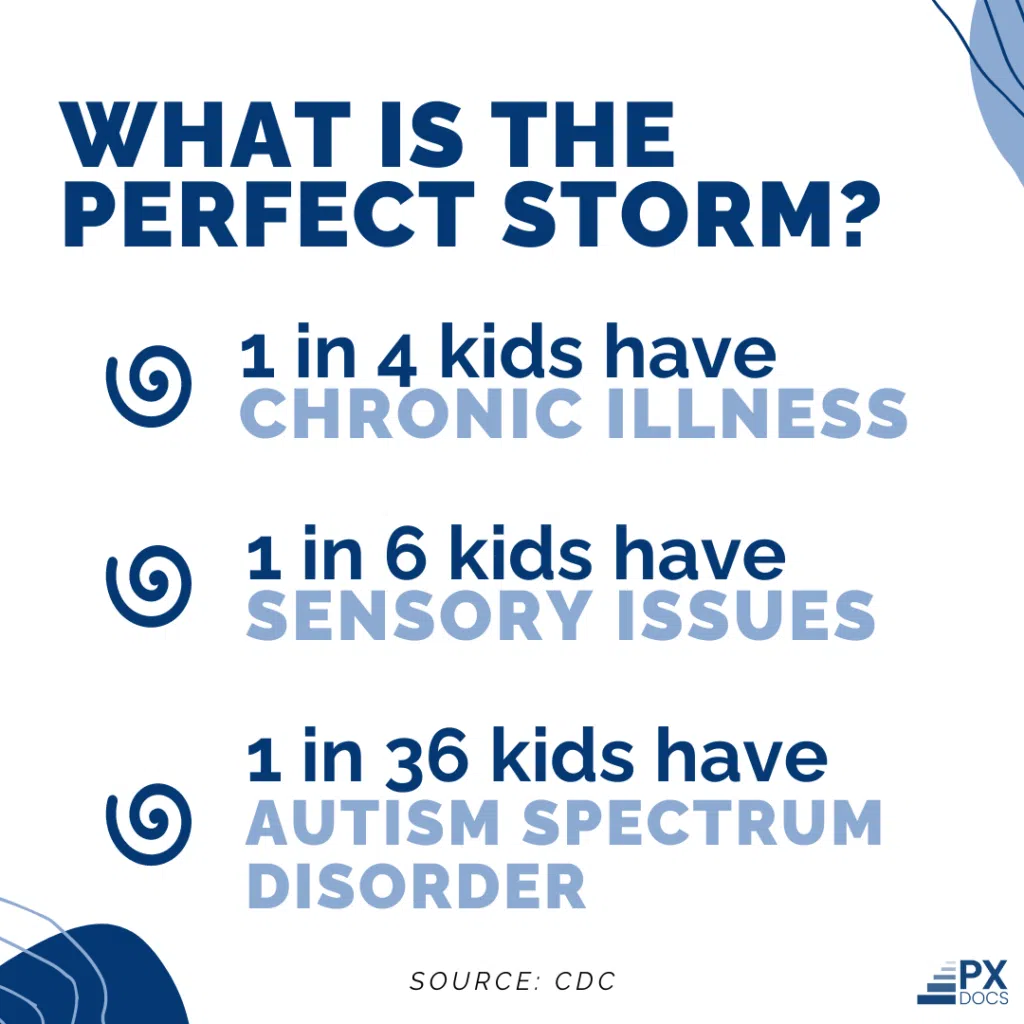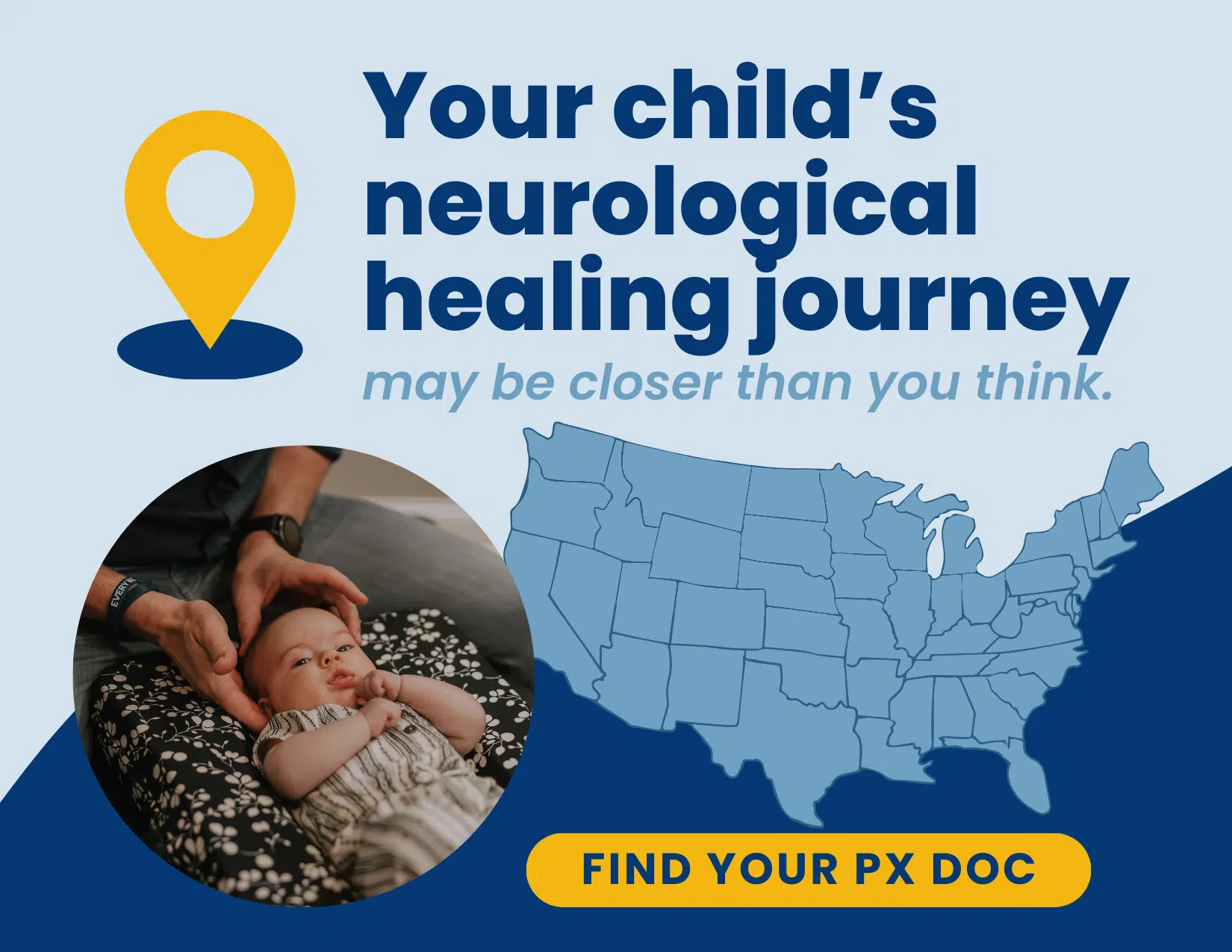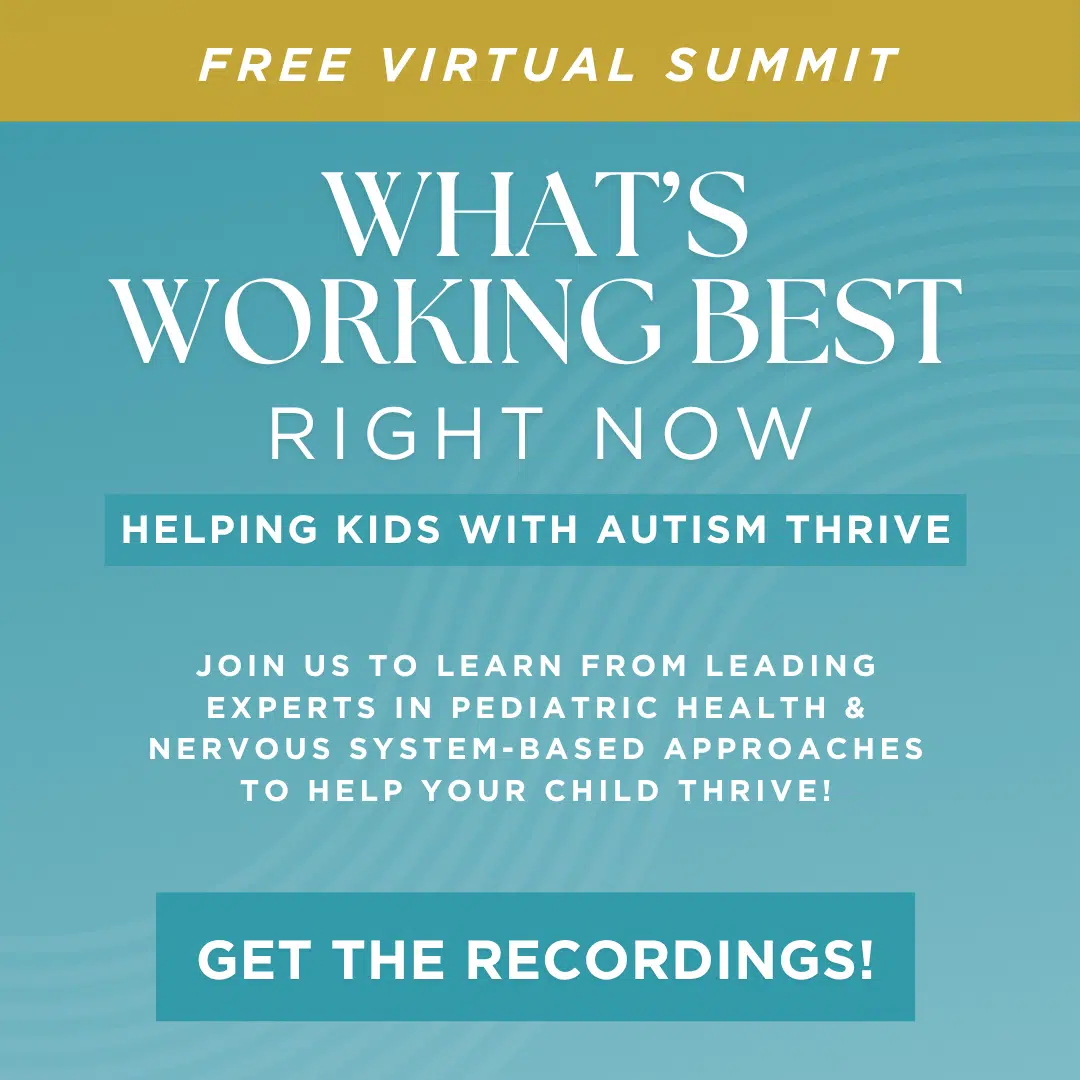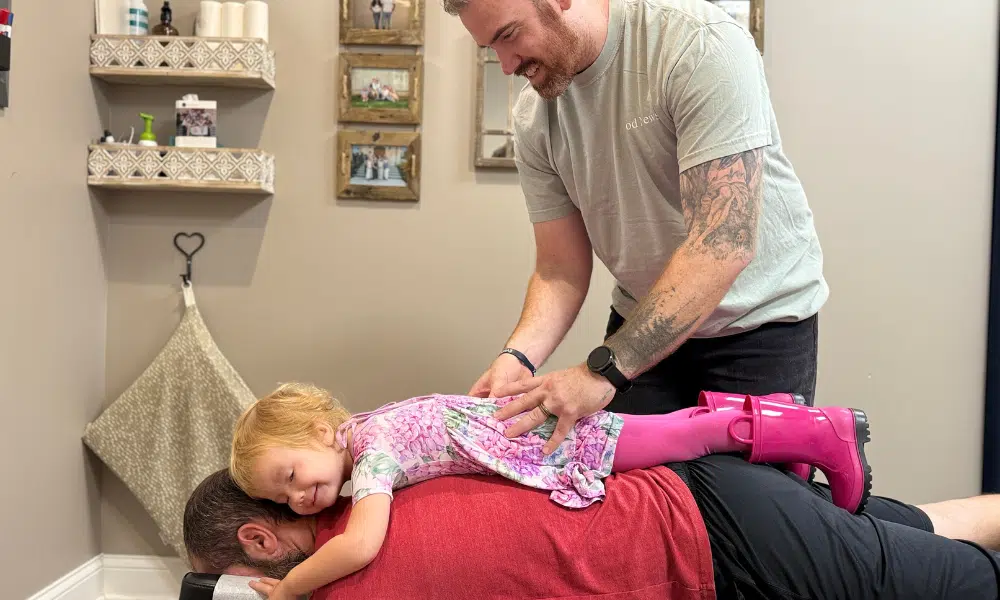In recent years, parents and healthcare professionals have been grappling with an alarming trend: the skyrocketing rates of chronic illness among children.
It’s estimated that 20% of children in the United States have special healthcare needs, and over 40% of school-aged kids have a chronic condition. Trends like these continue to rise.
From Autism and ADHD to allergies and autoimmune disorders, today’s children are facing an unprecedented array of health challenges that can impact every aspect of their lives.
But what is causing this epidemic of pediatric illness, and what can be done to address it?
The answer lies in understanding an epidemic we call “The Perfect Storm.” This term refers to a series of factors—including fertility challenges, prenatal stress, birth trauma, environmental toxins, and nervous system dysfunction—that can set the stage for developmental delays and chronic health problems in children.
Today, we’re covering everything about “The Perfect Storm” and exploring how this series of events can affect your child’s health and development. We’ll also discuss the crucial role of the nervous system in regulating overall health and well-being and introduce you to the power of Neurologically-Focused Chiropractic Care as a drug-free, non-invasive approach to addressing the root causes of chronic illness.
It’s time to stop blaming genetics and bad luck, but also let parents know the truth that it’s not simply exposure to gluten and environmental toxins either. There is more to the story. Our genetics take thousands of years to change and toxins have been around for multiple generations. And lastly, it’s not enough to say we’re simply “diagnosing” things like autism and anxiety better. Chronic illness in our kids is skyrocketing, and it’s time we dig deeper and get into the real root causes, instead of continuing to just scratch the surface.
If you are a parent searching for answers, we have them. If you are a healthcare provider looking to expand your knowledge, this article is for you, too. By the end, you’ll have a clear understanding of “The Perfect Storm” and how it can impact your child’s health, as well as practical steps you can take to help your child thrive. So let’s get started!
Understanding “The Perfect Storm”
The term “Perfect Storm” refers to a combination of factors that, when occurring together, create a situation that is much worse than each factor alone. In pediatric health, “The Perfect Storm” describes a convergence of stressors that can disrupt a child’s nervous system development and lead to chronic illness.
The PX Docs “Perfect Storm” framework consists of:
- Fertility challenges
- Prenatal stress
- Birth interventions
- Frequent exposure to toxins, including the overuse of antibiotics and other medications
- Compromised gut microbiome and immune system function
Each of these builds from one to the next until you have a child who has an overworked, dysfunctional, and dysregulated nervous system. This leads to disrupted and delayed neurological and brain development during the most sensitive or critical periods of development, starting as early as the in-utero fetal development period and then immediately being thrown off track during the crucial infant, toddler, and early childhood stages.
Common conditions that typically occur with a “Perfect Storm” include:
- Colic
- Constipation
- Chronic Ear Infections
- Missed Milestones and Developmental Delays
- Autism Spectrum Disorder
- Attention-Deficit/Hyperactivity Disorder (ADHD)
- Sensory Processing Disorder
- Emotional regulation and/or mental health conditions like Anxiety
Let’s take a deeper, evidence-based look at each step of the “Perfect Storm.”

Fertility Challenges and Chronic Health Issues in Kids Later In Life
Recent studies like this one continue to show a link long observed in clinical practice, that infertility and interventions like IVF increase the risk of autism and suboptimal neurodevelopment in children later on in life.
We now know that these fertility challenges, medical interventions, and many other factors during the fertility and prenatal journey can negatively impact fetal development and, most especially, the formation and functioning of the autonomic nervous system and vagus nerve. The autonomic nervous system and vagus nerve are absolutely essential for maintaining homeostasis and optimal neurodevelopment throughout every stage of life, so any disruption and damage to its development and delicate balance is bound to have negative effects and implications throughout development.
The Role of Prenatal Stress and Maternal Health
One key component of “The Perfect Storm” is prenatal stress and maternal health. Research has shown that high levels of stress during pregnancy can have a profound impact on fetal development, increasing the risk of conditions like ADHD, Autism, and anxiety later in life.
Well-established research published in 2009 found that maternal stress during pregnancy can alter the development of the fetal nervous system, leading to changes in brain structure and function. These changes can make children more susceptible to neurodevelopmental disorders and mental health challenges.
Birth Trauma and Interventions
Another critical factor in “The Perfect Storm” is birth trauma and interventions, such as C-sections, forceps delivery, and vacuum extraction. These procedures can cause stress and injury to the delicate tissues of the head, neck, brainstem, and spine, leading to subluxation, which is better understood as neurological interference or dysfunction within the neurospinal system. Subluxation disrupts the communication between the brain and body, causing nervous system dysregulation and overall imbalance, known as dysautonomia. This interference affects the body’s ability to maintain balance, respond to stress, and develop properly, contributing to a wide range of health issues and developmental delays in children.
We will dive deeper into subluxation and dysautonomia later, two important factors that lead to the “Perfect Storm” and are completely overlooked and missed by traditional pediatricians and medical testing.
A recent analysis shows that 80% of babies born via C-section grow up to have sensory issues. The global C-section rate has risen significantly from about 7% in 1990 to 21% today. This trend is projected to continue, with the global C-section rate expected to reach 29% by 2030.
Environmental Toxin, Medications, and the Toxic Load Theory
In addition to prenatal stress and birth trauma, environmental toxins and the overuse of medications in early childhood can also contribute to “The Perfect Storm.” Exposure to toxins like heavy metals, pesticides, and air pollution has been linked to an increased risk of neurodevelopmental disorders like Autism, immune dysfunction, and other chronic health problems.
For a comprehensive look at the rising rates of neurodivergent diagnoses, including Autism, read this article.
Overusing antibiotics and other medications in early life can also disrupt the delicate balance of the gut microbiome, which plays a crucial role in immune function and nervous system development. A 2019 study suggests that exposure to antibiotics in the first 24 months of life can affect neurocognitive outcomes, like cognitive function, hyperactivity, impulsivity, emotional regulation, and anxiety at 11 years of age.
The Impact on Gut Health and Immune Function
The combined effects of prenatal stress, birth trauma, environmental toxins, and antibiotic overuse can have a profound impact on a child’s gut health and immune function. When the gut microbiome is disrupted, it can lead to a cascade of health problems for your child, including digestive issues, allergies, autoimmune disorders, and neurological conditions.
Research has shown a strong connection between gut health and brain function, known as the gut-brain axis. A 2023 review showed that children with ASD and ADHD share the same distinct gut bacteria profiles. It is well-documented that there is a link between gut health and other mental conditions such as anxiety and depression.
By understanding the complex interplay of factors that contribute to “The Perfect Storm,” parents and healthcare providers can take steps to prevent and address chronic illness in children. In the next section, we’ll explore the nervous system’s critical role in regulating health and development and how neurologically-focused chiropractic care can help children thrive.

The Neurological Connection
To fully understand how “The Perfect Storm” can lead to chronic health issues in children, it’s essential to recognize the nervous system’s critical role in overall health and development. The nervous system consists of two main components:
- The central nervous system (CNS), which includes the brain and spinal cord.
- The autonomic nervous system (ANS) regulates involuntary functions like heart rate, digestion, and immune response.
Subluxation and Its Impact on Nervous System Function
From a Neurologically-Focused Chiropractic Care viewpoint, subluxation is defined as a neurological dysfunction that occurs when misalignments, tension, and restricted mobility build up within the neurospinal system, interfering with communication between the brain and body via the nervous system. This interference disrupts the body’s ability to regulate and adapt to its environment, leading to an imbalance in the autonomic nervous system and a range of physical, mental, and emotional health challenges.
Key components include:
- Misalignment + Limited Motion: Improper alignment and restricted movement patterns within the neurospinal system alter and disrupt sensory and motor input into the brain and nervous system.
- Neurological Interference: Disruption in the flow of neurosensory signals between the brain and body, often impacting vital functions such as digestion, immune response, motor tone and coordination, as well as behavioral and emotional regulation capacities.
- Autonomic Imbalance (Dysautonomia): The interference caused by subluxation often shifts the body into a state of sympathetic dominance, where the fight-or-flight response is overactive, suppressing the parasympathetic (rest and digest) system. This overall imbalance of the autonomic nervous system can lead to a whole range of other acute and chronic health challenges and is known as dysautonomia.
- Multi-System Dysfunction: Subluxation and dysautonomia can lead to dysfunction in multiple systems of the body, including immune, digestive, endocrine, motor, and emotional/behavioral regulation, as the nervous system struggles to maintain balance.
In essence, subluxation in Neurologically-Focused Chiropractic Care is viewed not just as a structural issue in the spine but as a deeper disruption in the body’s ability to communicate, adapt, and heal naturally.
Dysautonomia: The Result of “The Perfect Storm”
When the nervous system is subjected to the multiple stressors of “The Perfect Storm,” it can result in a condition called dysautonomia. Dysautonomia refers to a dysfunction of the autonomic nervous system, which can cause an imbalance between the sympathetic “fight or flight” response and the parasympathetic “rest and digest” response.
Because the vagus nerve is such an essential and important component of the parasympathetic system and overall autonomic regulation, dysautonomia also involves vagus nerve dysfunction and altered vagal nerve tone.
Symptoms of dysautonomia can include:
- Chronic fatigue
- Dizziness and fainting
- Digestive problems
- Anxiety and depression
- Sleep disturbances
- Immune dysfunction
Research has shown that children with neurodevelopmental disorders like Autism and ADHD have a higher prevalence of dysautonomia, suggesting a strong link between nervous system dysfunction and these conditions.
Dysautonomia is also strongly linked to seizures and epilepsy, as well as two unfortunately rapidly emerging conditions PANS / PANDAS. Each of these conditions is known to be triggered and made worse by excessive sympathetic tone and expression, and then in turn suppressed or exhausted vagus nerve and parasympathetic tone and responsiveness.
The Importance of the Vagus Nerve
One of the most critical components of the autonomic nervous system is the vagus nerve, which is the longest cranial nerve in the body. The vagus nerve plays a vital role in regulating many essential functions, including:
- Heart rate and blood pressure
- Digestion and gut motility
- Inflammation and immune response
- Mood and emotional regulation
- Sleep dysfunction and insomnia
When the vagus nerve functions properly, it helps to promote a state of relaxation and healing. However, when it is impaired due to subluxation or other stressors, it can contribute to a wide range of chronic health problems.
By understanding the neurological connection between “The Perfect Storm” and chronic health issues in children, parents and healthcare providers can take a more targeted approach to prevention and care. In the next section, we’ll explore some of the specific health challenges that can arise from nervous system dysfunction and how Neurologically-Focused Chiropractic Care can help.
Health Challenges Arising from the “Perfect Storm”
When the nervous system is compromised due to the “Perfect Storm,” children can develop a wide range of chronic health issues that affect multiple systems in the body. These challenges can significantly impact a child’s quality of life and lead to ongoing struggles for the entire family.
Some of the most common health problems associated with nervous system dysfunction include:
Digestive Issues
Digestive problems are among the most prevalent health challenges faced by children with subluxation and dysautonomia. When the autonomic nervous system is not functioning properly, it can disrupt the normal digestive process, leading to conditions such as:
- Constipation
- Acid reflux
- Irritable bowel syndrome (IBS)
- Food sensitivities and allergies
A 2016 study published in Neurology examined autonomic dysfunction in ASD and found that:
- Five out of six patients with ASD reported significant gastrointestinal symptoms, including constipation, diarrhea, and early satiety.
- All patients in the study showed signs of orthostatic intolerance, which is a form of autonomic dysfunction.
- Gastrointestinal motility testing was performed on two patients, with one showing signs of gastroparesis.
Respiratory Problems
Children with nervous system dysfunction are also more susceptible to respiratory issues, such as:
- Asthma
- Allergies
- Chronic ear, nose, and throat infections
- RSV
- Croup
- Chronic cough
- Sleep-disordered breathing (e.g., sleep apnea)
Subluxation can exacerbate these conditions by interfering with proper nerve communication to the respiratory system, as well as contributing to excessive sympathetic responses and systemic inflammation. A 2001 study found that after three months of chiropractic care for pediatric asthma, children rated their quality of life substantially higher and their asthma severity lower.
Neurodevelopmental Disorders
“The Perfect Storm” can also contribute to the development of neurodevelopmental disorders, such as:
- Autism Spectrum Disorder (ASD)
- Attention-Deficit/Hyperactivity Disorder (ADHD)
- Sensory Processing Disorder (SPD)
- Learning disabilities
Research has shown that children with these disorders often have underlying nervous system dysfunction, which can be addressed through neurologically-focused interventions.
There are numerous studies providing hopeful insights for caring for children with Autism through Neurologically-Focused Chiropractic Care, which focuses on regulating the autonomic nervous system, stimulating the vagus nerve, and improving the overall function of the nervous system.
Mental Health Challenges
Nervous system dysfunction can also have a profound impact on a child’s mental health, leading to conditions such as:
- Anxiety disorders
- Depression
- Obsessive-Compulsive Disorder (OCD)
- Oppositional Defiant Disorder (ODD)
- Tic disorders
Dealing with these challenges can be difficult for children and families, as they often need a multifaceted care approach. While talk therapy, counseling, and other drug-free interventions are very helpful and provide benefits, many kids and families report they aren’t quite enough to help address the root cause of their child’s mental and emotional health struggles.
What is more, parents today are quite aware of the dangers and limitations of psychoactive drugs and medications, which are now prescribed to millions upon millions of kids, teens, and young adults. These medications rely on the now frequently debunked chemical imbalance theory, which states that patients simply suffer from a genetic imbalance of neurotransmitters.
But if we simply break that word into two parts, “neuro” and “transmitters,” it actually helps reveal the real root cause of these challenges—an imbalance in the nervous (neuro) system and interference, imbalance, and disruption of the communication (transmission) between the brain, body, and environment.
This is where Neurologically-Focused Chiropractic Care comes in and seeks to dive deeper into the root cause, neurological imbalance, and interference, and help patients see marked improvements in their quality of life without having to rely on hard-hitting, dependency-forming drugs and medications. Additionally, many parents and patients report that once chiropractic adjustments kick in and begin to calm, regulate, and improve nervous system function, their child now responds much better to talk therapy, deep breathing exercises, and other stress regulation and modulation interventions that were previously unsuccessful.
Autoimmune Conditions
Finally, the “Perfect Storm” can set the stage for the development of autoimmune conditions, such as:
- Celiac disease
- Type 1 diabetes
- Juvenile rheumatoid arthritis
- Pediatric Autoimmune Neuropsychiatric Disorders Associated with Streptococcal Infections (PANDAS)
These conditions occur when the immune system mistakenly attacks healthy cells in the body, leading to chronic inflammation and a wide range of symptoms.
By understanding the potential health challenges arising from the “Perfect Storm,” parents can take proactive steps to support their child’s nervous system function and overall well-being. In the next section, we’ll explore how neurologically-focused chiropractic care can help address the root cause of these issues and promote optimal health in children.
The PX Docs Solution: Neurologically-Focused Chiropractic Care
For parents seeking a drug-free, non-invasive approach to addressing the root causes of the “Perfect Storm,” Neurologically-Focused Chiropractic Care offers a promising solution. PX Docs, a network of specially trained Pediatric Chiropractors, is at the forefront of this transformative approach to children’s health and well-being.
Restoring Nervous System Function
The primary goal of Neurologically-Focused Chiropractic Care is to restore proper function to the nervous system by addressing subluxation and dysautonomia. Through gentle, specific adjustments, PX Docs chiropractors work to reduce nerve interference, improve neurological function and regulation, and promote optimal communication between the brain and body.
The PX Docs Approach
What sets PX Docs apart is their comprehensive, personalized approach to pediatric chiropractic care. This approach includes:
- Neurological Assessments: PX Docs chiropractors use state-of-the-art technology, such as INSiGHT scans, to objectively assess a child’s nervous system function and identify areas of subluxation and dysautonomia.
- Personalized Care Plans: Based on the neurological assessment results, PX Docs chiropractors develop individualized care plans tailored to each child’s unique needs and goals.
- Gentle, Specific Adjustments: PX Docs chiropractors are trained in various gentle, non-force techniques that are safe and effective for children of all ages, including infants and toddlers.
Real-Life Success Stories
The impact of Neurologically-Focused Chiropractic Care on children’s health and well-being is best illustrated through real-life success stories. You can find many stories of hope here.
These stories demonstrate the potential for Neurologically-Focused Chiropractic Care to help children affected by the “Perfect Storm” achieve optimal health and reach their full potential.
You can also hear the stories of experts and parents alike sharing messages of hope and healing on the Experience Miracles™ Podcast.
Recognizing the Signs and Seeking Early Intervention
One of the most important things you can do as a parent is to be aware of the signs and symptoms of nervous system dysfunction, such as:
- High stress fertility and pregnancy period
- Birth interventions and trauma
- Developmental delays
- Early signs of autism
- Missed milestones
- Chronic ear infections
- Sleep and digestive challenges
- Sensory sensitivities
- Behavioral challenges
- Chronic illness
If you suspect your child may be struggling with the effects of the “Perfect Storm,” seeking early intervention is key. Addressing these issues in the early stages of development can help prevent long-term health challenges and set your child on a path to optimal wellness.
Finding a Qualified PX Doc: The PX Docs Directory
When finding a qualified Pediatric Chiropractor who understands the unique challenges of the “Perfect Storm,” the PX Docs directory is an invaluable resource. This directory connects parents with a network of highly trained and experienced chiropractors specializing in children’s Neurologically-Focused Chiropractic Care.
To find a PX Doc near you, visit the directory and enter your location. You can also browse provider profiles to learn more about their specific areas of expertise and approach to care.
Partnering with Your PX Doc for Your Child’s Health
When you partner with a PX Docs chiropractor, you can expect a collaborative, supportive relationship focused on your child’s individual needs and goals. During your initial appointment, your PX Doc will conduct a thorough neurological assessment and discuss your child’s health history, as well as any concerns you may have.
Based on this information, your PX Doc will develop a personalized care plan that may include regular chiropractic adjustments, lifestyle recommendations, and coordination with other healthcare providers as needed.
As you work together to implement this plan, you can expect ongoing communication and support from your PX Doc and periodic reassessments to track your child’s progress.
Hope, Healing, and Empowerment in the Face of the Storm
The “Perfect Storm” of prenatal stress, birth trauma, environmental toxins, and nervous system dysfunction has created a rising tide of chronic health challenges for today’s children. But there is hope. By understanding the root causes of these challenges and seeking Neurologically-Focused Pediatric Chiropractic Care support, parents can help their children navigate the “Perfect Storm” and achieve optimal health and well-being.
At PX Docs, we are committed to empowering parents with the knowledge, resources, and support they need to make informed decisions about their child’s health. Our network of skilled and compassionate Pediatric Chiropractors is dedicated to helping children of all ages overcome the effects of the “Perfect Storm” and reach their full potential.
If you suspect your child may be struggling with the impact of the “Perfect Storm,” we encourage you to take the first step towards healing and schedule an appointment with a PX Docs provider today. Together, we can help your child navigate the “Perfect Storm” challenges and emerge stronger, healthier, and more resilient on the other side.
Visit the PX Docs directory to find a Qualified Pediatric Chiropractor near you and start your journey toward optimal health and well-being for your child and your entire family.






